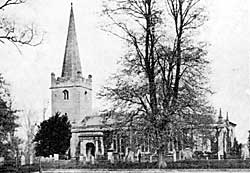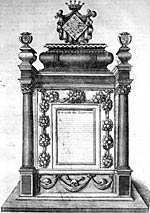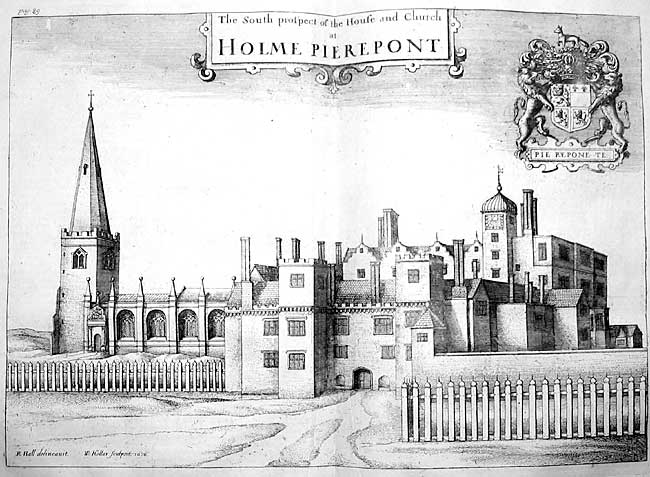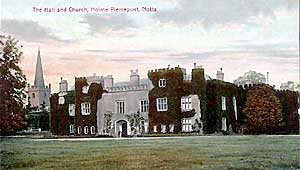
The church of St Edmund, Holme Pierrepont, c.1900.
DURING the Great Pillage under Edward VI, the church of Pierrepoint was sadly despoiled. From the three bells in the tower to the brass stoup for holy water it was ravaged and robbed. The warrior Sir Henry had given a vestment worth £10 and as the church had recently been partly rebuilt, it is probable that others had also presented adornments, but they seem to have disappeared: even a vestment described as "rent and rotten" was carried off, but perhaps some of the treasures had been hidden and were brought out again when Mary restored the "Old Religion" after her brother's short reign. The old rector, who had been instituted in 1527, was ejected from the living, but in 1554 another Romish priest took his place and the Romish missals wore restored. Father Roger Smyth proved to be of the type of the celebrated Vicar of Bray, for he conformed to the Protestant creed in the time of Elizabeth and retained his position here until 1577 when he resigned to become rector of Cotgrave, and died in 1595.
In 1608, when Anne, Queen of James I, was journeying from Scotland to the coronation, she came here from Hardwick, and was entertained with her train at the Hall. Her host, Sir Henry Pierrepoint, had married a daughter of the famous "Bess of Hardwick," and the tomb which that intriguing countess erected to his memory, now beside the south wall, is one of the more prominent of the numerous old memorials in the church. Next year the memory of this splendour was eclipsed by a terrible plague which decimated the village.
The Pierrepoint association with Thoresby dates from 1634, when Robert Pierrepoint, first Earlof Kingston, purchased the old mansion there, but it was not until after the death of his son, "Wise William," the friend of Cromwell and Monk, that its park was formed and the family took up its residence there to the detriment of their ancient seat at Holme. That earl, after considerable hesitations, threw in his lot with the king, and in 1643 was slain in a boat on the Trent. His son stayed at the old family home and Lucy Hutchinson complained that he "could not be persuaded to engage his father's tenants nor use his power which might then have been very advantageous to Parliament." It was well for the people of Holme Pierrepoint that this restraint was exercised; it was bad enough to nave to pay heavy war levies and to be called upon for supplies by either side, but, although Parliament made the Pierrepoints pay smartly to save their estates, the village was spared the painful sight of its men being set up against the church walls and shot.
Hall Enlarged
The second earl, who was created Marquis of Dorchester, clung to the old seat here and he improved the mansion in many ways. He enlarged it and laid out fine new grounds in accordance with the luxurious taste of the Restoration era. John Evelyn, the diarist, in 1664 described the Hall as "a noble place"; it had apparently been heightened by then, and in 1724 Sir Thomas Parkyns said that the mansion and its gardens could be seen from the High Pavement at Nottingham. About 1666 the church was largely rebuilt upon its old foundations, but in a different style, Gothic features being blended in its exterior with a quasi-Classical element which was then just coming into fashion. As then left, it had assumed its present appearance and it is regarded "as genuine work of the period in which neither money nor care were begrudged."

"Here lyeth the illustrious Princess Gertrude, Countess Of Kingston, daughter to Henry Talbot..."
The imposing monument inscribed to "the illustrious Princess Gertrude, Countess of Kingston," who died in 1640, has been a mystery to many visitors, but the riddle is easily solved. She was a granddaughter of the third Earl of Shrewsbury and wife of the 1st Earl of Kingston, and the appropriation of the royal designation was merely a piece of flattering persiflage characteristic of the earlier part of the 17th century. John Oldham, whose cracked tablet remains, was one of the most famous of the Caroline poets who, as a friend of the marquis, was a permanent guest at the Hall in which he died in 1633.
"Fox And Crown"
The "Fox and Crown" inn is mentioned in the parish accounts of 1670, when the churchwardens paid "2s. 6d. to tho clock man" for "looking to the clock," and 10s. 6d. to the tavern landlord for something of which the details are not specified.
An ecclesiastical return of 1678 shows that here were then 70 inhabitants of age to partake of the Sacrament; there were three Papists and four other Dissenters, who would be Puritans or Quakers. A similar return in 1743 reported 25 families of nominal church- goers, with one Independent and one Romanist. The rector then was the Rev. Scrope Berdmore, who was also vicar of St.
Mary's, Nottingham and of Cropwell Bishop. He informed his archbishop that "publick service is read in the church every Lord's Day twice, unless I am prevented by accident, which does not often happen." Yet he had no curate here.
The opening year of the 18th century found Holme Pierrepoint involved in war matters once again, but this time indirectly; in 1701 it was called upon to pay £25 11s. 3d. as its share of the grant-in-aid for maintenance of the war with France. As the century closed the English and French nations were yet again at war, and the village raised a troop of yeomanry towards the homeland defence.
In 1718, the rector (Humphrey Perkins) left £30 to be put out at interest, and the proceeds to be distributed among the poor at Christmas. Dame Frances Pierrepoint, in the time of James I, had left a portion of a charity to the parish, and in 1720, John Clayton bequeathed £10 for the same benevolent purpose. In 1750 most of these funds were merged for the purchase of a close in Lambley which yielded timber for sale. Gamston and Basingfield took a fourth part of this income which was distributed in six-penny loaves at Yuletide, and Holme Pierrepoint had 45s. a year which was given in small amounts among the poor. In 1828 the Charity Commissioners drew attention to the fact that £40 of this charity money was on deposit at Wright's Bank in Nottingham at 2 per cent and suggested that it should be profitably invested. Its yield now is nearly £6.
Diminished Glories

Holme Pierrepont Hall and church in 1676 (from Thoroton's Antiquities of Nottinghamshire). The north range (at the back) was rebuilt by Robert Pierrepont in 1628 and demolished in the 1730s.
In the heyday of its glory the Hall was a quadrangular Tudor structure which had been enlarged by successive owners, but in the 18th century much of it was destroyed as no longer required, and today only the east wing and part of the south front exist. Thoresby had become the chief family residence and in the reign of George II the bowling green here had become a popular resort of the better class folk of Nottingham who attended regularly on Thursdays and had refreshments served. It was the second (and last) Duke of Kingston who was chiefly responsible for diminishing the Hall; he died in 1773, leaving all his possessions for her life to his wife Elizabeth Chudleigh, who was convicted in 1778 of marrying him bigamously. The duke's will was contested by his nephew, Chas. Medowes, who recovered part of the estates by lawsuits and the rest, at her death in 1783. The duchess had only once seen the Hall and the proximity of the churchyard made her dislike it. She willed to be buried in the church beside her husband with her coffin chained to his, but this whim was not gratified. Mr. Medowes was successively created Viscount Newark, Baron Pierrepoint, and, in 1805, Earl Manvers.

The Hall and Church, Holme Pierrepont, c.1910.
It is said the "wicked Lord Byron" was among those who came here to play bowls with the Mr Chaworth whom he afterwards slew in the noted duel in the dark in 1765, and the poet-lord also reputed to have played upon its green. In 1814 the house was encased in its stone-like stucco; it was then the seat of the heir to the title. Later it served as a dower-house, and in later days was let for private occupation.
Grow More Food
Agriculture made great progress under George III, and in this Holme Pierrepoint bore its part. Three farmers, Messrs. Bettison, Sandys, and Stubbings devoted scientific attention to it, the first two improving the supply of beef milk through the introduction of cows of the noted Dishley strain, while the last was a successful breeder of horses.
In 1794, the newly formed Trent Navigation Co. obtained powers to construct a lock in the Trent here. At that time the high price of corn was causing acute distress and "Grow More Food" was the order of the day. The local food effort as not prodigious, for whereas in that year it harvested 33qrs of wheat, 220 of barley, and 28 of oats, in 1705 the output was only 35qrs. of wheat, 254 of barley and 110 of oats.
In 1811 this was one of the South Notts, villages to which magistrates afforded protection against the Luddites, but the rioters seemed to have steered clear of it. It had then 191 inhabitants and thirty years later this had increased to its maximum of 220–13 more than in 1901. In 1919 the parish was included in Nottingham's abortive extension scheme; two years later the first sod of the new lock was turned, the work being completed in 1921, but it was reserved for 1941 to see the dispersal of the Manvers Estate here after some eight centuries of ownership by the Manvers family and their Pierrepoint descendants.
